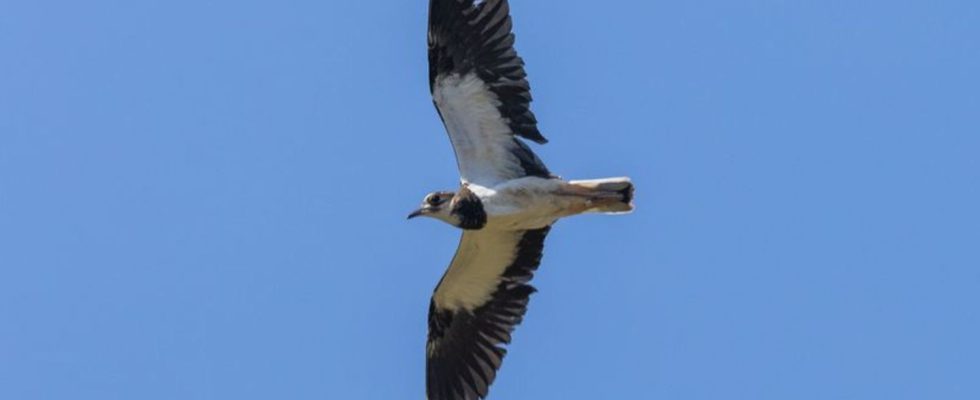The lapwing can be recognized by its striking plumage and its call: it sounds a bit like it is calling its name. Could he soon fall silent in Germany?
The lapwing stands out, no question about it. He has a bold tuft of feathers on the back of his head. Its plumage is white on the underside and dark on the upper side with a metallic green and purple shimmer. But if you want to observe the meadow breeder, which has now become rare, you need luck – or you have to know the right places.
One such is the Knoblauchsland on the outskirts of Nuremberg, one of the largest contiguous vegetable growing areas in Germany – and virtually a lapwing hotspot. The second largest population in Bavaria lives here in a comparatively small area.
“I have never seen so many together,” says Lisa Schenk from the Bavarian nature conservation association LBV. “It’s especially spectacular during courtship season. The males do a kind of aerial acrobatics to impress the females.” Being able to observe the lapwing so well is something special, even for the expert.
Drastic decline in inventory
According to the Red List of Threatened Species, the lapwing is now critically endangered. According to the latest figures, the umbrella association of German avifaunists estimates the population to be between 42,000 and 67,000 breeding pairs. As a result, this has fallen by around 90 percent since 1980. “This is a drastic cut,” says Martin Rümmler from the German Nature Conservation Association (Nabu). The main reason for this is the shrinking living space.
The lapwing loves moist meadows and pastures, moors and swamps. But many of them were drained in the past to be used for agriculture or to create building land. “One problem is that the lapwings move to arable land. This causes broods to be lost,” says Rümmler. Because tractors and other machines overrun the well-hidden nests, because there is less food for the young birds there, and because predators like foxes have an easier time there.
In order to draw attention to the endangerment of the pigeon-sized bird from the plover family and the importance of its habitat, Nabu and LBV have named the lapwing alongside the partridge (endangered), barn swallow, little owl and honey buzzard (all soon to be endangered) as “Bird of the Year” 2024 nominated. As in previous years, the population can decide who wins. Voting on the Internet will continue until Thursday morning.
Lower occurrence in southern Germany
While the lapwing is still widespread in northern Germany, it has a rather difficult time in southern Germany. That’s why experts like Lisa Schenk fight for every single bird there. This spring, together with volunteers, she searched the fields in Knoblauchsland for nests and marked more than 120 with poles so that farmers could avoid them when working in the fields.
But that’s only a fraction of the nests in the 4,000 hectare area, says Schenk. In the coming year, she and her team not only want to expand nest protection, but also investigate how many eggs actually hatch into young birds. “The eggs are also at risk of not making it through.” The LBV has also marked around 100 young lapwings in Knoblauchsland with colored rings in order to find out more about their migratory behavior and loyalty to the place of birth.
The lapwing is one of the so-called short-distance migrants. In autumn it leaves its breeding area to overwinter in milder regions, for example in France, Spain, Great Britain and the Netherlands. “A few stay here in Germany, some move away. But that also depends on the weather,” explains Nabu expert Rümmler.
Transmitters provide information about bird migration
But how many lapwings actually return from the dangerous journey in spring to their breeding grounds in Germany? To find out, Martin Boschert had eight young lapwings in Baden-Württemberg equipped with transmitters for the first time this year. The biologist is responsible for the protection of meadow birds such as the curlew and the lapwing on the Upper Rhine in Baden.
When Boschert discovers lapwing nests that would be destroyed during field work, he brings the clutches to the zoo in Karlsruhe. They are hatched there and the young birds are later released into the wild. Eight of them now carry a transmitter. “They all flew off to the west and southwest,” says Boschert. “We’re excited to see what happens when winter sets in.”
The lapwing was once widespread across southern Germany, says Boschert. “We have to go back there.” For example, he fences in the nests of meadow breeders to protect eggs and chicks from foxes, polecats, martens and raccoons. There have already been successes with the curlew, he says. “We’re seeing more and more young birds coming up.”
Leisure pressure endangers breeding success
Some areas are even completely closed during the breeding season through a general decree from the municipality, except for agriculture, hunters and nature conservation associations, explains Boschert. This is to prevent people from spooking the birds while walking or jogging and dogs running loose killing the chicks. Thanks to the various measures, the lapwing population in the main area has increased again, says Boschert. “He’s at the level he was 10, 15 years ago.”
According to Nabu expert Rümmler, protection projects like those in Baden-Württemberg and Nuremberg make sense in order to stabilize local populations. “As far as the overall population is concerned, that’s a drop in the ocean. The big adjustment screw is agricultural policy,” he says. In order to save the lapwing, more areas would have to be protected and rewetted. In addition, fewer pesticides would have to be used in agriculture so that the lapwing can find enough insects to eat again.

